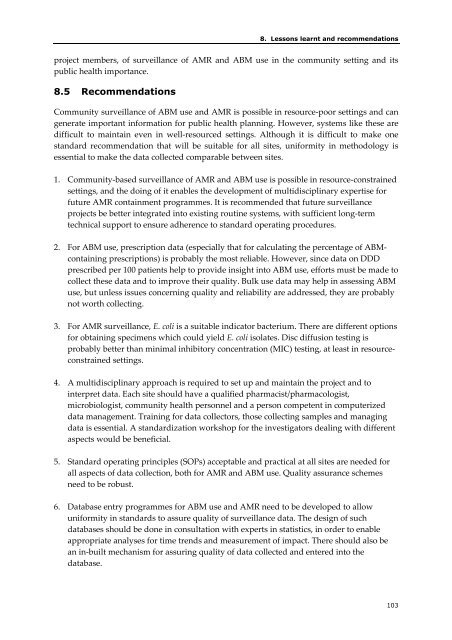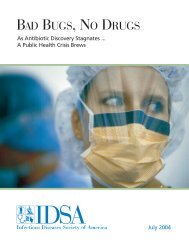Community-Based Surveillance of Antimicrobial Use and ...
Community-Based Surveillance of Antimicrobial Use and ...
Community-Based Surveillance of Antimicrobial Use and ...
- No tags were found...
Create successful ePaper yourself
Turn your PDF publications into a flip-book with our unique Google optimized e-Paper software.
8. Lessons learnt <strong>and</strong> recommendationsproject members, <strong>of</strong> surveillance <strong>of</strong> AMR <strong>and</strong> ABM use in the community setting <strong>and</strong> itspublic health importance.8.5 Recommendations<strong>Community</strong> surveillance <strong>of</strong> ABM use <strong>and</strong> AMR is possible in resource‐poor settings <strong>and</strong> cangenerate important information for public health planning. However, systems like these aredifficult to maintain even in well‐resourced settings. Although it is difficult to make onest<strong>and</strong>ard recommendation that will be suitable for all sites, uniformity in methodology isessential to make the data collected comparable between sites.1. <strong>Community</strong>‐based surveillance <strong>of</strong> AMR <strong>and</strong> ABM use is possible in resource‐constrainedsettings, <strong>and</strong> the doing <strong>of</strong> it enables the development <strong>of</strong> multidisciplinary expertise forfuture AMR containment programmes. It is recommended that future surveillanceprojects be better integrated into existing routine systems, with sufficient long‐termtechnical support to ensure adherence to st<strong>and</strong>ard operating procedures.2. For ABM use, prescription data (especially that for calculating the percentage <strong>of</strong> ABMcontainingprescriptions) is probably the most reliable. However, since data on DDDprescribed per 100 patients help to provide insight into ABM use, efforts must be made tocollect these data <strong>and</strong> to improve their quality. Bulk use data may help in assessing ABMuse, but unless issues concerning quality <strong>and</strong> reliability are addressed, they are probablynot worth collecting.3. For AMR surveillance, E. coli is a suitable indicator bacterium. There are different optionsfor obtaining specimens which could yield E. coli isolates. Disc diffusion testing isprobably better than minimal inhibitory concentration (MIC) testing, at least in resourceconstrainedsettings.4. A multidisciplinary approach is required to set up <strong>and</strong> maintain the project <strong>and</strong> tointerpret data. Each site should have a qualified pharmacist/pharmacologist,microbiologist, community health personnel <strong>and</strong> a person competent in computerizeddata management. Training for data collectors, those collecting samples <strong>and</strong> managingdata is essential. A st<strong>and</strong>ardization workshop for the investigators dealing with differentaspects would be beneficial.5. St<strong>and</strong>ard operating principles (SOPs) acceptable <strong>and</strong> practical at all sites are needed forall aspects <strong>of</strong> data collection, both for AMR <strong>and</strong> ABM use. Quality assurance schemesneed to be robust.6. Database entry programmes for ABM use <strong>and</strong> AMR need to be developed to allowuniformity in st<strong>and</strong>ards to assure quality <strong>of</strong> surveillance data. The design <strong>of</strong> suchdatabases should be done in consultation with experts in statistics, in order to enableappropriate analyses for time trends <strong>and</strong> measurement <strong>of</strong> impact. There should also bean in‐built mechanism for assuring quality <strong>of</strong> data collected <strong>and</strong> entered into thedatabase.103




